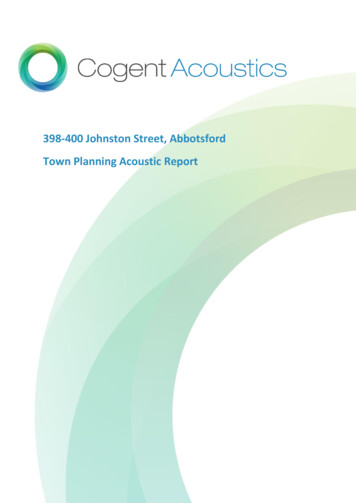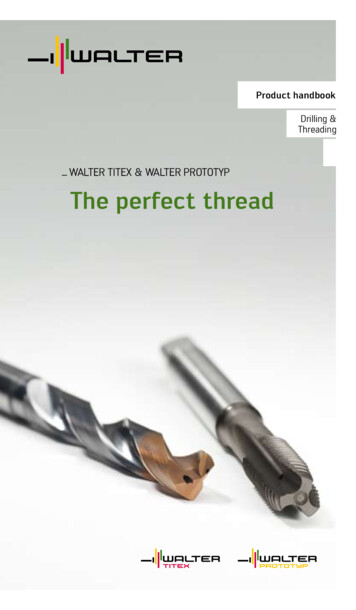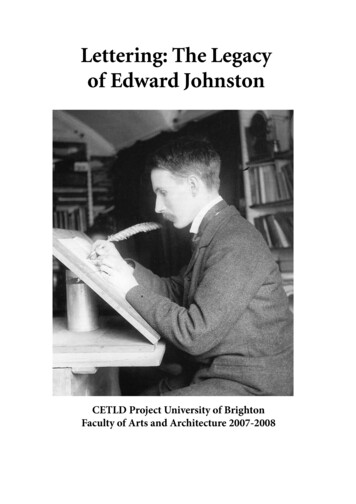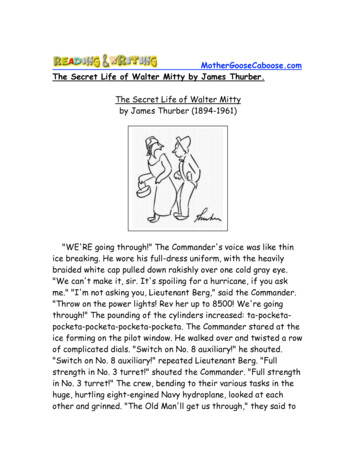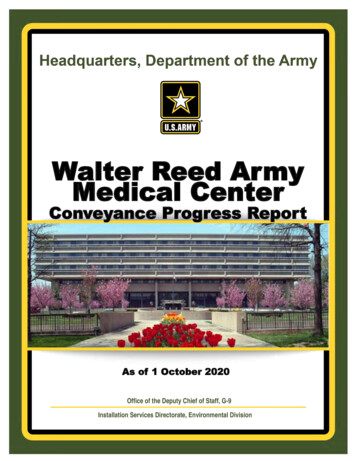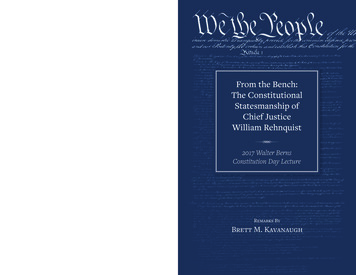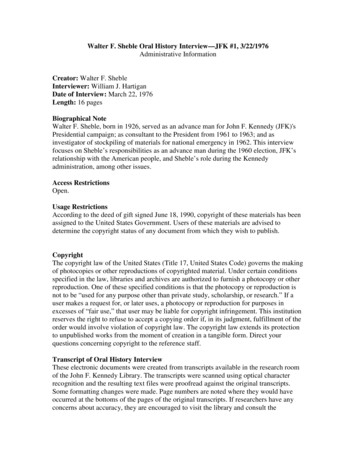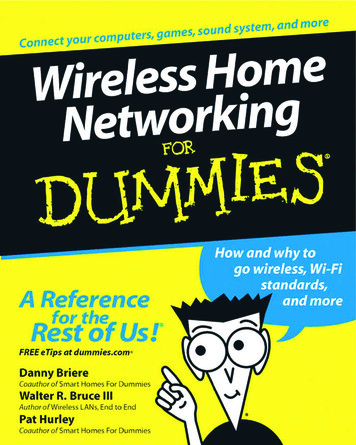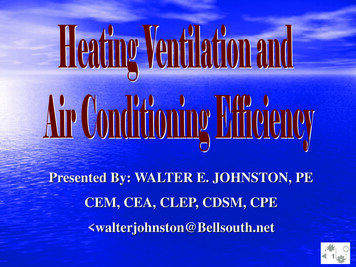
Transcription
Presented By: WALTER E. JOHNSTON, PECEM, CEA, CLEP, CDSM, CPE walterjohnston@Bellsouth.net1
Functions of HVAC SystemsThe purpose of a Heating, Ventilation and AirConditioning (HVAC) system is to provide andmaintain a comfortable environment within abuilding for the occupants or for the process beingconductedMany HVAC systems were not designed withenergy efficiency as one of the design factors2
AirAir is the major conductor of heat.ORLack of heat air conditioning3
Basics of Air ConditioningBtu – Amount of heat required to raise onepound of water 1 F 0.252 KgCal1 Poundof WaterAbout 1 Pint of Water 1 Large Glass 1 Kitchen Match 1 Btu4
5
Low Cost Cooling Unit6
7
Typical Design Conditions75 degrees F temperature50% relative humidity30 – 50 FPM air movement15 – 20 CFM outside air per person orCO2 less than 1,000 PPMASHRAE 62 – 1989 Ventilation Standard8
Typical HVAC System and Energy Users9
Typical AC Operating System10
HVAC Air FlowsWhat were your Design Air Flows (cfm)?What are Actual Air Flows (cfm)?Where do YOU want the air flows to be?11
Building Air Flow Schematic12
Fan Law3 RPM 2 CFM 2 CHANGE IN KW RPM 1 CFM 1 RPM 1 100 RPM310%RPM 2 90 RPM3 90 KW 2 .73 100 27% Reduction in Energy13
Fan Law SavingsFan Law SavingsElectric MotorsPercent Energy 730%20%1410%0%0%10%20%30%40%50%60%70%80%90% 100%Percent Reduction in Speed14
Varying Fan CFM1. Variable Speed Drives2. Two Speed Motors3. Intel/Exhaust Dampers4. Variable Speed Sheaves5. Change Standard Sheaves6. Magnetic Coupling7. Variable Pitch Fans15
Uses of V.A.V.1. Varying People Loads2. Varying Inside/Outside Temperature3. Time of Day4. Sun/Wind Position Load Changes5. Temperature Adjustment (Internal)16
Single Zone System17
Multi-zone Systems18
Dual Duct System19
Terminal Reheat System20
HVAC Systems and Controls – Control StrategiesBasic/Typical Control Strategies OA closed on night cycle OA closed on morning warm up Fans off at night (unless heating called for) Hot/chilled water temperature reset with respect to OA temperature Exhaust fans locked out at night SA temperature reset with respect to zone needing most heat/cooling Time clock control of equipment (e.g. boiler, pneumatic air, fans, etc.) Economizer cycle Optimum start/stop Demand limiting Duty cycling21
Geographic Location/Degree Days/Weather DataExampleAssume a period of three days when the outsidetemperature averages 50 F (10 C) each dayThe number of HDD for this three-day period would be:HDD (65 - 50 ) x 3 days 45 degree daysHDD (18.33 - 10 ) x 3 days 25 days22
Air-to-Heat Recovery“Run-Around Cycle”make-up coilsair make-uppumpinsideoutsidecirculatingheat transferfluidexhaustexhaust coils23
Cogged V BeltsA major N.C. Manufacturer Tested 2-17 Months (yr 1985) .052/KWH (.13 EP) 2700 Hours/YearCOGGED BELTSTANDARD BELTPREMIUM BELT15 HP 10.67 3.33 7.34BRAND A 4.4%BRAND B 1.0%AT 4.4% THE POTENTIAL SAVINGS IS 69.50/YEARMANUFACTURERS PREDICT 2-6 TIMES LIFEDO NOT USE ON ROCK CRUSHERS, ETC.24
Waste Heat Recovery25
Psychometric ChartThe Relationship of 8 Properties of Air1.2.3.4.5.Dry Bulb TemperatureWet Bulb TemperatureDew Point TemperaturePercentage Relative HumidityMoisture Content (weight of water vapor in 1 lb. ofdry air, given in grains) (7,000 grains 1 lb.6. Enthalpy (quantity of heat in each lb. of dry air,Btu/lb. of dry air)7. The Volume Occupied by Each Pound of Air8. Vapor Pressure due to the Presence of Water26
Psychometric Chart27
Waste Energy ChecklistVentilation1. Excess outside air intake2. Outside air damper not properly adjusted3. Leaking or defective outside air damper seals4. Clogged filtersInfiltration5. Broken or cracked window panes6. Rotted or defective weather stripping7. Loose or missing caulking8. Poor window alignmentInfiltration9. Defective weather stripping10. Misaligned doors11. Missing or defective caulking12. Gaskets or other seals defective13. Defective door closer14. No personnel access doors at garage oroverhead doorsHeating and Cooling15. Nonexistent operating schedule – unnecessaryheat or cooling in unoccupied spaces16. Thermostat set too high or low17. Defective thermostat18. Defective limit switches19. Storage areas mixed with office or personnelspaces, which could be maintained at a lowertemperature20. Unnecessary heat in garages, docks or loadingplatforms21. Exhaust fans running when not needed22. Open drapes or shades during cool weather whensun is not shinning23. Process heat not isolated from personnel spaces24. Unnecessary extra backup system operation25. Mixture of fuel and air not properly maintained28
Waste Energy ChecklistRefrigeration Equipment26. Moisture in refrigerant27. Leaks in refrigerant system28. Clogged strainers or filters29. Worn drive belts30. Slipping drive belts31. Insulation missing from suction and liquid lines32. Dirty heat exchanger or condenser fins and coils33. Condenser located near hot-process equipment orlocated in direct sunlight34. Corrosive or mineral-laden water being used35. Bent or unbalanced fans36. Dirty fan blades37. Clogged nozzles in cooing tower spray bars38. Missing slats in cooling tower39. Dirty louvers40. Restricted flowBOILERS:41. Scale deposits in boiler or system42. Soot accumulation in tubes43. Defective door gaskets44. Pressure and temperature set too high45. Burner out of adjustment46. Loose or worn linkages47. Defective fuel solenoid valve48. Dirty nozzles or cup on oil-fired49. Defective insulation50. Leaks in fuel line51. Dirty oil strainer52. Defective igniter53. Air lock in radiators54. Dirty radiators29
Waste Energy Checklist55. Obstructed air flow56. Dirty infrared reflectors57. Low voltage or heating elementsHumidification or DehumidificationEquipment58. Dirty dampers or fan parts59. Defective nozzles or medium pads60. Leaking ductwork61. Defective insulation on ducts62. Obstructed ducts63. Dumper blades defective64. Air valves no properly seated65. Mixing dampers not properly adjusted66. Dirty grills or diffusers67. Broken or missing deflector68. Moisture accumulation in ductwork69. Air leaks in pneumatic system70. Low air pressure in supply tank71. Clogged filter pads on intake30
Heating and Cooling. 15. Nonexistent operating schedule - unnecessary heat or cooling in unoccupied spaces. 16. Thermostat set too high or low. 17. Defective thermostat. 18. Defective limit switches. 19. Storage areas mixed with office or personnel spaces, which could be maintained at a lower temperature. 20. Unnecessary heat in garages .
